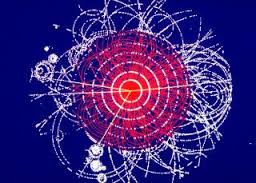So far so good, but…
…it is not time for physicists to call it a day just yet. Even though the Standard Model is currently the best description there is of the subatomic world, it does not explain the complete picture. The theory incorporates only three out of the four fundamental forces, omitting gravity. There are also important questions that it does not answer, such as “What is dark matter?”, or “What happened to the antimatter after the big bang?”, “Why are there three generations of quarks and l eptons with such a different mass scale?” and more. Last but not least is a particle called the Higgs boson, an essential component of the Standard Model.
eptons with such a different mass scale?” and more. Last but not least is a particle called the Higgs boson, an essential component of the Standard Model.
On 4 July 2012, the ATLAS and CMS experiments at CERN’s Large Hadron Collider (LHC) announced they had each observed a new particle in the mass region around 126 GeV. This particle is consistent with the Higgs boson but it will take further work to determine whether or not it is the Higgs boson predicted by the Standard Model. The Higgs boson, as proposed within the Standard Model, is the simplest manifestation of the Brout-Englert-Higgs mechanism. Other types of Higgs bosons are predicted by other theories that go beyond the Standard Model.
On 8 October 2013 the Nobel prize in physics was awarded jointly to François Englert and Peter Higgs „for the theoretical discovery of a mechanism that contributes to our understanding of the origin of mass of subatomic particles, and which recently was confirmed through the discovery of the predicted fundamental particle, by the ATLAS and CMS experiments at CERN’s Large Hadron Collider.”
So although the Standard Model accurately describes the phenomena within its domain, it is still incomplete. Perhaps it is only a part of a bigger picture that includes new physics hidden deep in the subatomic world or in the dark recesses of the universe. New information from experiments at the LHC will help us to find more of these missing pieces.


